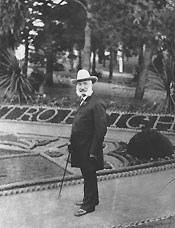
PARC, GGNRA Adolph Sutro was a German-born inventor of Jewish heritage. He was an entrepreneur and real estate developer who helped shape the landscape of late 19th century San Francisco. Interested in providing inexpensive recreation for the general public, he changed San Francisco's sparse and undeveloped Point Lobos area into a flourishing recreational complex that during its heyday boasted the Cliff House, Sutro Baths and Sutro Heights. Made his fortune in the Silver Mines Adolph Heinrich Joseph Sutro was born April 29, 1830 in Germany. Sutro arrived in California in 1850 and was well educated in the field of mining engineering and business. Sutro made his fortune in the late 1860s and 1870s at the Comstock Lode silver mines in Nevada where he designed and constructed a massive tunnel that drained and ventilated the flooded mines shafts. The construction of the Sutro Tunnel is recognized as having improved significantly the working conditions of the miners themselves, and diminished risks to their health and safety. This combination of ingenuity and benevolence characterized Sutro's later work in San Francisco. Purchased San Francisco coastal land After his work in the silver mines, Sutro moved back to San Francisco where he wanted his large real estate plans to help benefit others. In 1881, Sutro purchased 22 acres of undeveloped land at the edge of the city, which included a promontory overlooking the Cliff House and Seal Rocks, and provided breathtaking views of the Pacific Ocean, Mount Tamalpais, and the Golden Gate. Sutro turned this property into Sutro Heights, an elaborate public garden that was open to all citizens. Sutro laid out the grounds to take advantage of the ocean views and filled the garden with forests, decorate flower beds, statues and vista points. 
PARC, GGNRA Revitalized the Cliff House In 1883, Sutro purchased the Cliff House, a restaurant originally constructed in 1863 that had, over the years, become fairly run-down and shabby. Sutro wanted to re-establish the restaurant as a wholesome, family-friendly venue. After the first Cliff House was destroyed by a fire in 1894, Sutro spent $75,000 to rebuild and furnish the second Cliff House. The new Cliff House, designed in an ornate, Victorian style, stood eight stories tall and provided elegant dining rooms, art galleries and panoramic views from open-air verandas. Created Sutro Baths for public health and recreation Sutro's interest in natural history and marine studies prompted him to develop the idea of creating an ocean pool, or aquarium, among the rocks north of the Cliff House. Sutro continued to expand his ocean front complex with the development of a massive public bath house, or swimming facility. Sutro Baths was created as a huge swimming and bathing facility, offering six saltwater swimming tanks of varying sizes, shapes and water temperatures that provided exercise and recreation to the San Francisco public. When Sutro Heights opened to the public in 1885, it could be reached only by private carriage or by a costly railroad. In keeping with his desire to ensure that everyone, not just the rich, could his enjoy his park, Sutro supported development of a new steam rail line designed to bring people from downtown to the Cliff House for half the cost of a fare on the competing line. Sutro's political involvements and role as San Francisco's public benefactor led him to a two-year term of city mayor, from 1895 to 1897. Adolph Sutro died in San Francisco, August 8, 1898, leaving behind him a legacy of public recreational facilities for his fellow San Franciscans. For Further Reading Adolph Sutro; A Biography. Robert E. Stewart, Jr. and Mary Frances Stewart; Howell-North Books, Berkeley, CA, 1962. To learn more about the history of the Sutro area, download the Sutro Historic District National Register nomination form. |
Last updated: June 24, 2025
